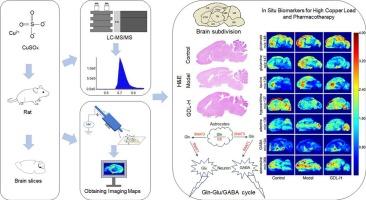Changes in neurotransmitter metabolic profiles in copper-loaded rats as assessed by mass spectrometry imaging and the effect of Gandouling intervention
IF 4.2
2区 医学
Q1 NEUROSCIENCES
引用次数: 0
Abstract
Copper accumulation-induced cognitive impairment represents a significant clinical manifestation in patients with Hepatolenticular Degeneration (HLD). Neurotransmitters play a crucial role in cognitive function, but the effects of their metabolic changes in different brain regions on cognitive dysfunction remain unclear. Thus, we employed desorption electrospray ionization mass spectrometry imaging (DESI-MS) to observe molecular metabolic disturbances and spatial distribution in the brains of copper-loaded rats. The results showed that there were certain changes in metabolic substance levels in nine brain regions of copper-loaded rats, and the cortical region showed the most significant changes, including increased levels of glutamine, adenosine, taurine, and other substances; and decrease levels of γ-aminobutyric acid, hypoxanthine, and other substances. Collectively, these changes suggest disruptions in the glutamine (Gln)-glutamate (Glu)/γ-aminobutyric acid (GABA) cycle. Notably, Gandouling tablets (GDL) intervention restored cognitive abilities in the water maze and reduced copper levels. This study highlights that copper accumulation may induce cognitive deficits by disrupting neurotransmitter balance; conversely, GDL may protect cognitive function by restoring this balance.

质谱成像评估铜负荷大鼠神经递质代谢谱的变化及甘多灵干预的影响。
铜积累引起的认知障碍是肝豆状核变性(HLD)患者的一个重要临床表现。神经递质在认知功能中起着至关重要的作用,但其在不同脑区代谢变化对认知功能障碍的影响尚不清楚。因此,我们采用解吸电喷雾质谱成像(DESI-MS)技术观察了铜负载大鼠脑内的分子代谢紊乱及其空间分布。结果表明,铜负荷大鼠脑内9个区域代谢物质水平均有一定变化,以皮质区变化最为显著,包括谷氨酰胺、腺苷、牛磺酸等物质水平升高;并降低γ-氨基丁酸,次黄嘌呤和其他物质的水平。总的来说,这些变化表明谷氨酰胺(Gln)-谷氨酸(Glu)/γ-氨基丁酸(GABA)循环被破坏。值得注意的是,肝兜灵片(GDL)干预可以恢复水迷宫中的认知能力,并降低铜水平。这项研究强调,铜的积累可能通过破坏神经递质平衡而导致认知缺陷;相反,GDL可能通过恢复这种平衡来保护认知功能。
本文章由计算机程序翻译,如有差异,请以英文原文为准。
求助全文
约1分钟内获得全文
求助全文
来源期刊

Experimental Neurology
医学-神经科学
CiteScore
10.10
自引率
3.80%
发文量
258
审稿时长
42 days
期刊介绍:
Experimental Neurology, a Journal of Neuroscience Research, publishes original research in neuroscience with a particular emphasis on novel findings in neural development, regeneration, plasticity and transplantation. The journal has focused on research concerning basic mechanisms underlying neurological disorders.
 求助内容:
求助内容: 应助结果提醒方式:
应助结果提醒方式:


